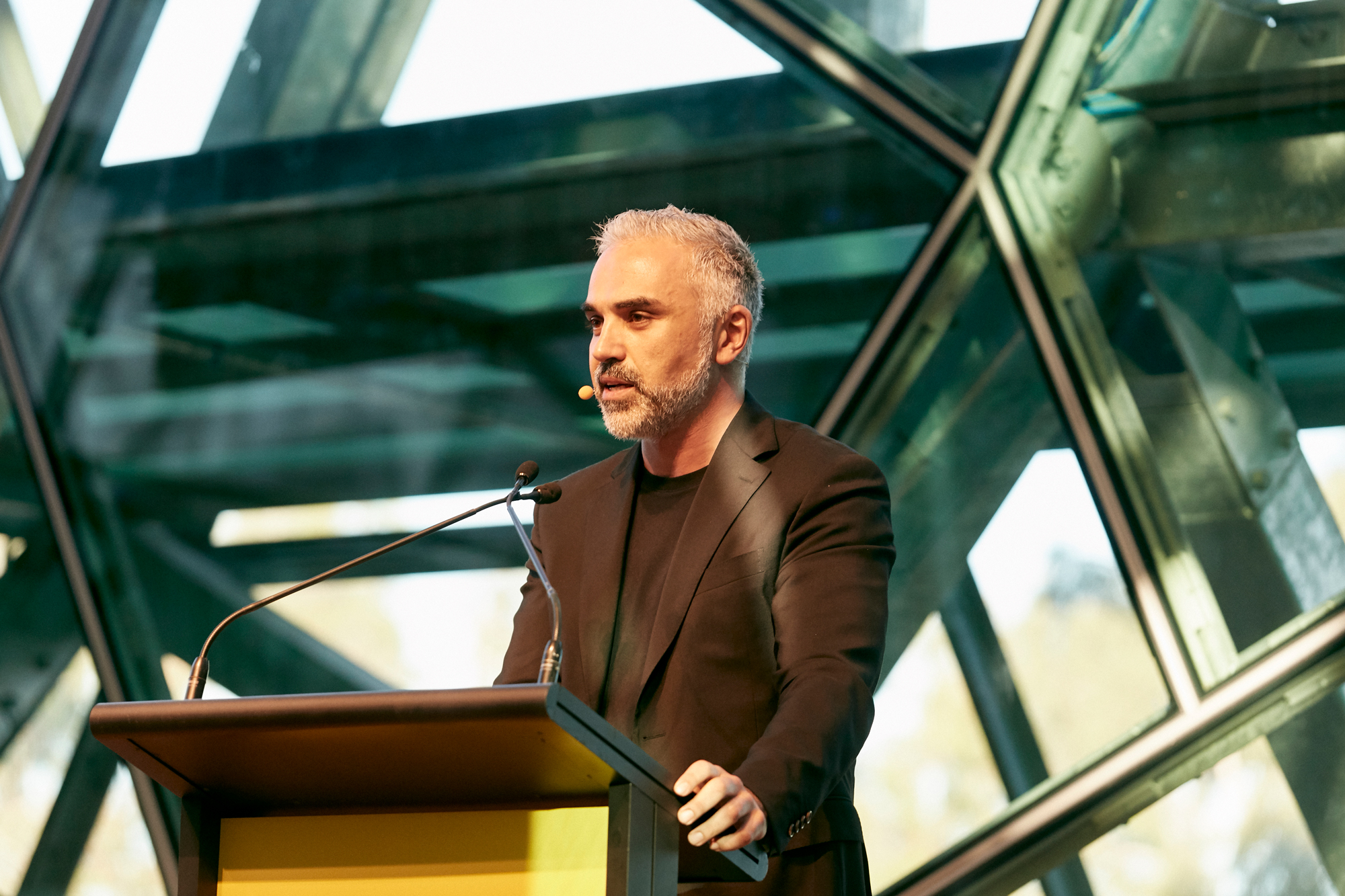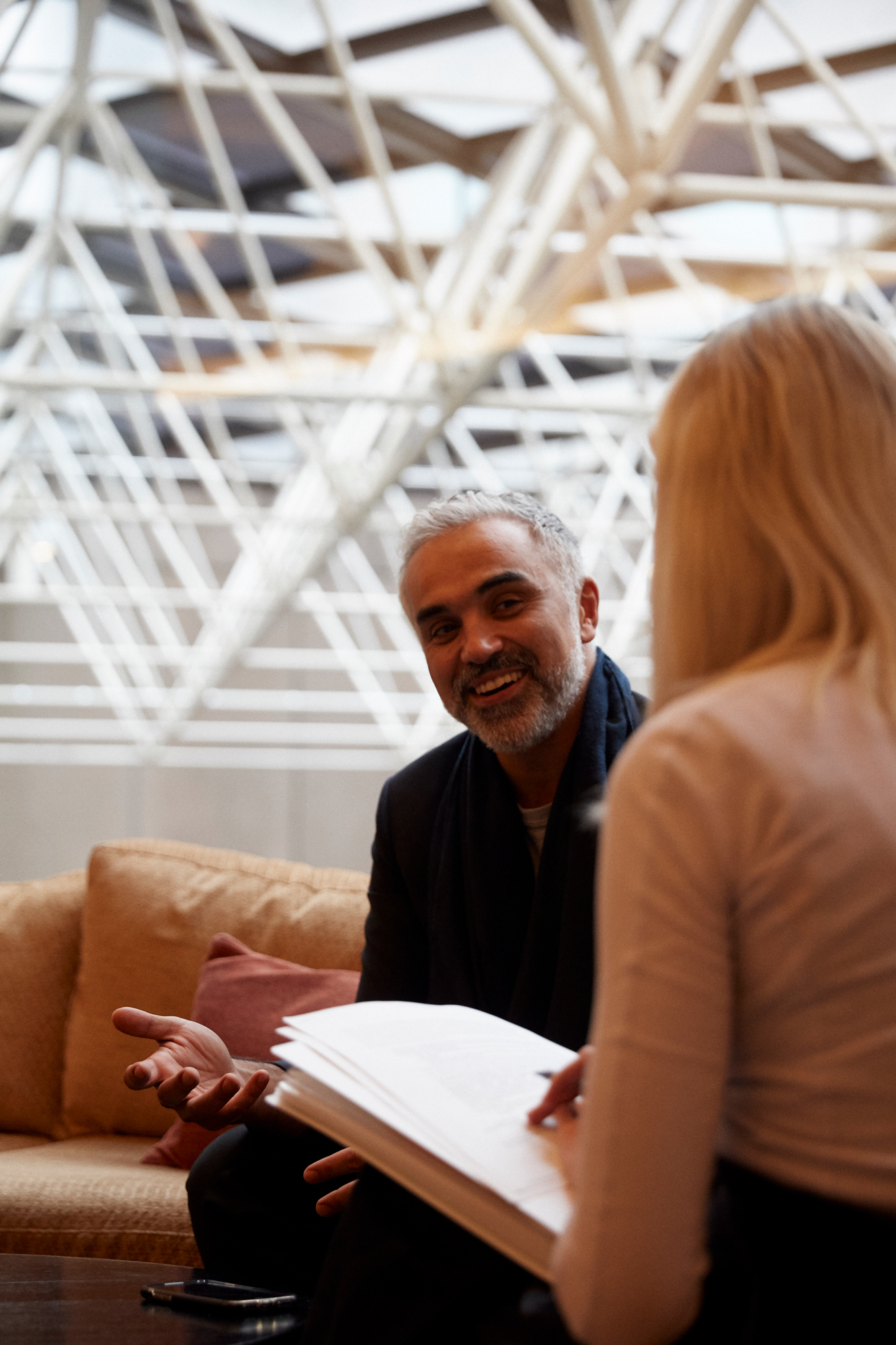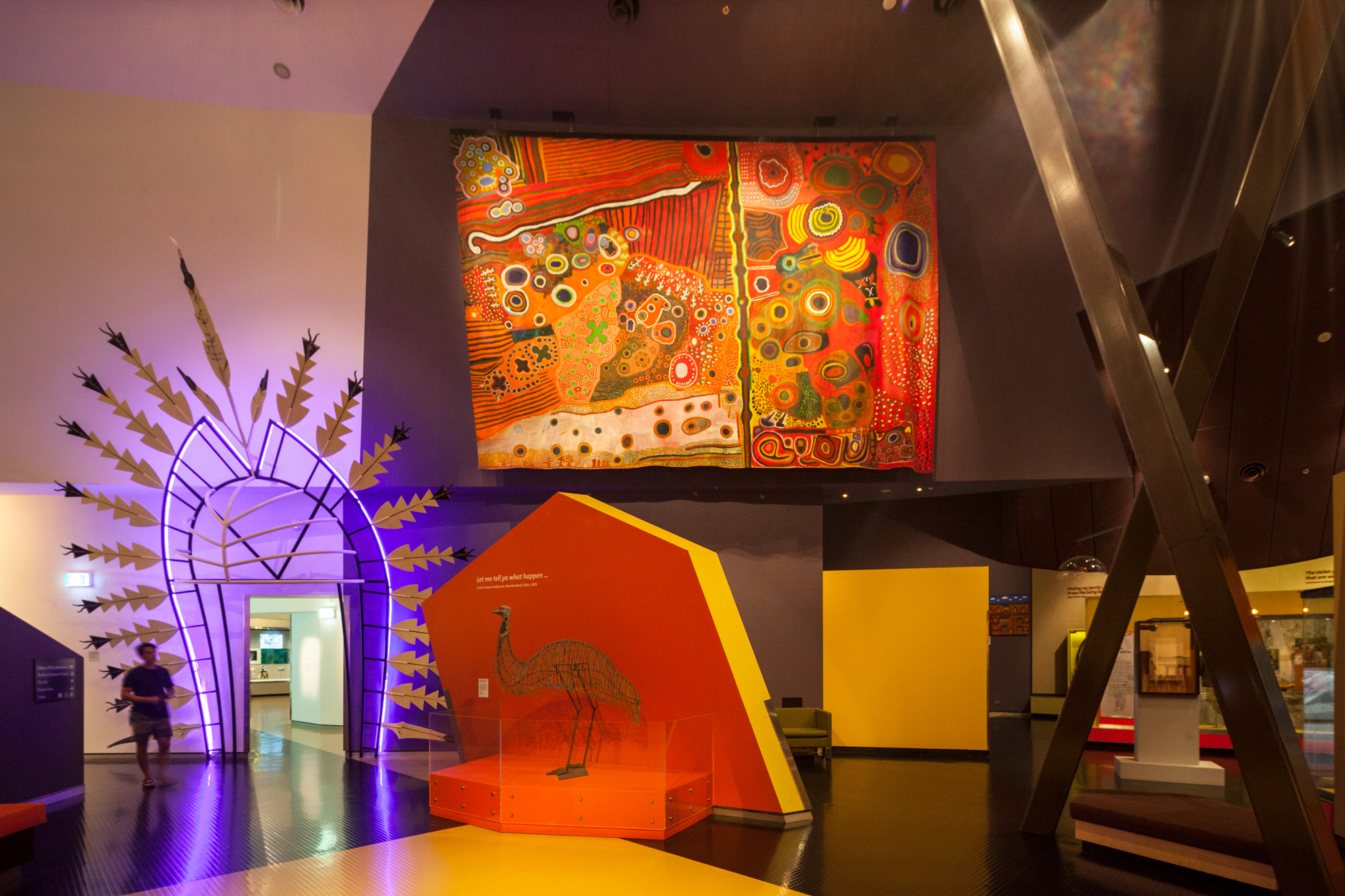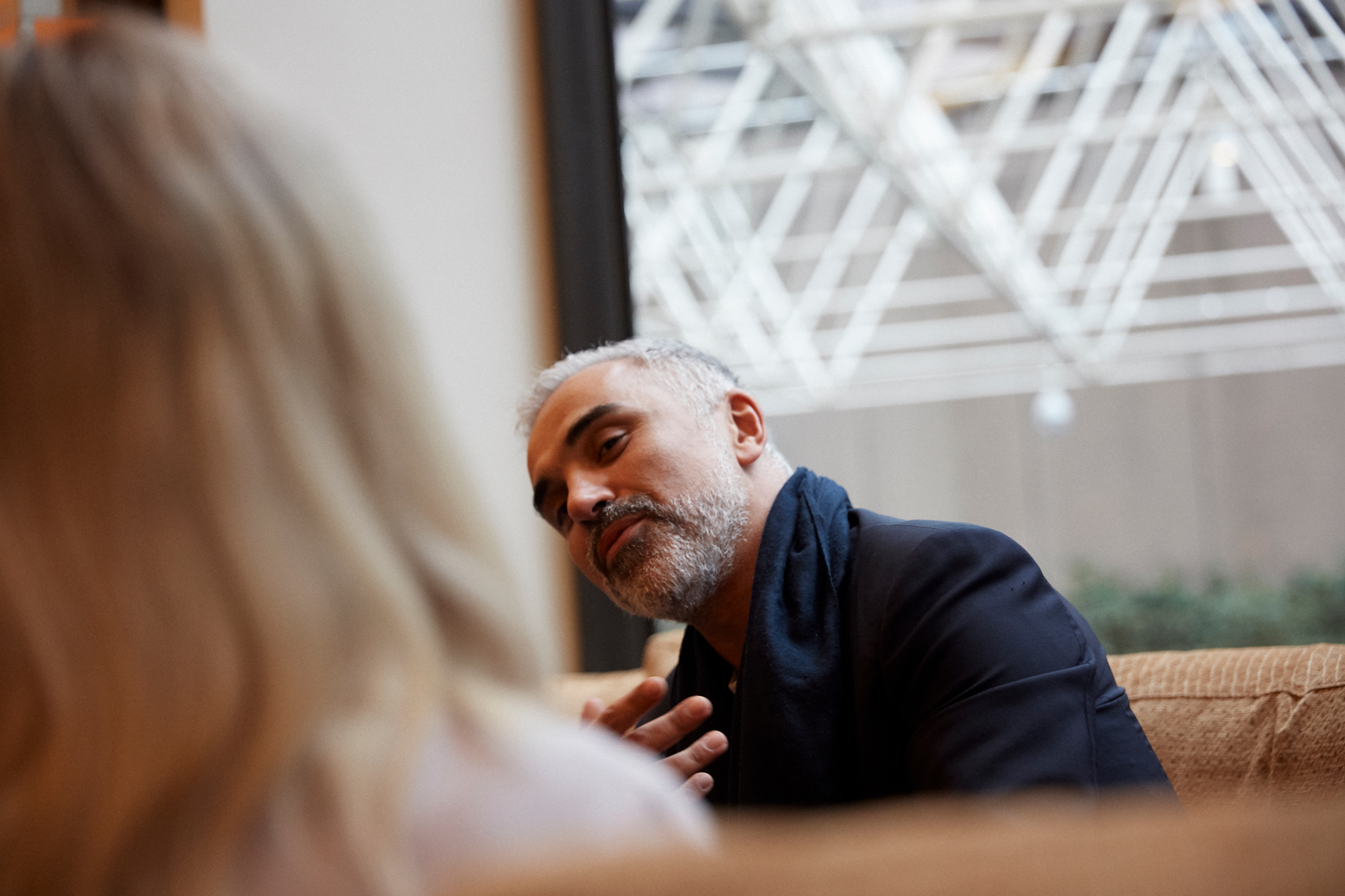Adrian Lahoud on the legacy of empire

Adrian Lahoud’s practice interrogates the intersection of architecture, climate change and colonisation. His curatorial strategy for Sharjah Architecture Triennial, ‘The Rights of Future Generations’, is the culmination of decades of research into the spatial consequences of conflict. Lauren Crockett sat down in conversation with Adrian, after his presentation at the Living Cities Forum in 2019.
Adrian’s earlier work on ‘post-traumatic urbanism’ was a reaction to the experience of being in Lebanon during the civil war. “It was about really trying to look beyond the rubble and the obvious materialisation of conflict. The way social groups reorganise, the way neighbourhoods contracted, the way demographics were sorted – those things became really interesting to me.” This fascination with conflict has evolved to encompass the greatest geopolitical threat we face as a species. “Since climate change,” he says, “it’s now a prerequisite for everyone to think in a much more systemic way.”


The contribution to, and experience of, climate change is not equally distributed among the world’s population. It is inextricably linked to colonisation, as “climate change is not a problem of humanity – it is a certain extractive mode of being that has overcome the earth”. Its violent effects will be felt relative to race, geographic location, social class and a mass of other determining factors; yet, when we are talking about “almost-certain extinction… it suddenly becomes a whole-species problem”.
It’s these vulnerable sites and people that constitute both the subjects and authors of the forthcoming Sharjah Architecture Triennial (9 November 2019–8 February 2020). Adrian defines the intention as “bring[ing] to attention spaces of alternate modes of existence that struggle to survive against the prospect of extinction”. After almost a decade focusing on Sub-Saharan Africa, the process of identifying these spaces has widened his sites of intrigue to include others dotted throughout the Global South: Ethiopia, Chile, Palestine and his birthplace, Australia. This singular Australian case study, of Ngurrara: The Great Sandy Desert Canvas by the Ngurrara people, formed the core of his presentation at the Living Cities Forum this year. Ngurrara Canvas was a vast painting undertaken in 1996 by members of the Walmajarri, Wangkajunga, Mangala and Juwaliny language groups. Ngurrara Canvas was their claim to nomadic occupation of their own territory – a region of more than 78,000 km2 near the Kimberley in Western Australia – for thousands of years; it’s a physical map of their country. The decision to grant land rights affirmed a previously non-existent commensurability between the Western conception of property and Indigenous relation to country.

Lauren Crockett
You align climate change with an ‘extractive’ mode of being, playing out at a planetary scale. How can this be understood at the scale of the individual?
Adrian Lahoud
The simplest example is the way we increasingly instrumentalise social relationships to gain credit, whether it’s financial credit or social credit. More and more things that were really intimate about human relationships become exposed to financialisation in ways that just didn’t exist before. Your likes and dislikes are monetised by major corporations – that’s the most obvious example.
One of the alternatives to this mode of being is reciprocity. Primitive societies often functioned by subsistence – a perfect equilibrium between the amount produced and the amount consumed. A White reading of this economic system would say that it was underperforming, as it did not produce a surplus. But there are societies and communities that don’t see human beings as a resource to be exploited; some of these appear in the Sharjah Triennial.
LCCould you elaborate on your own understanding of the Global North and Global South, and how you deploy the terms in your work?
ALI use it in quite a broad way to refer to conditions in which there is a legacy of colonialism or of ‘empire’. Latin America, Africa, the Middle East and South-East Asia were at one point or another the outposts of empires. They were used to supply labour, for the slave trade, their resources were exploited and extracted, and so on. So, there’s a kind of geography to former empires or former colonies. But it’s also a consequence of many, many different things like migration and the slave trade, and a continued form of inequality and racism within cities in the Global North – especially in the last few decades. You’ll find conditions in cities like London, New York, Sydney, Melbourne, in which the Global South appears within the Global North.
In a context like Australia, we can think about it in so many ways. The beat-up around Sudanese gangs that’s been happening here for the last few years is just the latest in a long line of outbursts of xenophobic rage in this country towards outsiders, whether they’re refugees, economic migrants – there’s no real nuance to it. The Sudanese are bearing the brunt of it now, the Lebanese bore the brunt of it in the early 2000s, before then it was the Vietnamese, and you can keep going back. Then, of course, there is the scandal that is Australia’s relationship to its First Nations people.
LCBeing an Australian working in London, as Dean of the School of Architecture at the Royal College of Art, but directing much of your focus towards Africa and the Middle East, what is your own relationship to the history of colonisation here?
ALMy relationship to being Australian is really complicated. I was born in Sydney, my parents were born in Lebanon and emigrated to Australia in 1956 and 1968, but I also grew up in an inner-western suburb in Sydney, where who was and wasn’t Australian seemed to be decided by white Australians. When I am introduced as Australian, I have to double-take, because on one hand I am, but I am also Lebanese.
My interest in issues surrounding Indigenous Australians is an elaboration of the last nine years of my work, looking at the impact of climate change on Sub-Saharan Africa, and thinking about the way different systems of knowledge production interact. It’s important to understand that interaction if you want to try to come to terms with climate change.
I read these two incredible books – The Biggest Estate on Earth and Dark Emu – that were a complete revelation to me. Like probably many people, I felt this overwhelming sense of humiliation for being part of this culture for so long – having been born here – and yet being incredibly ignorant about the history of this continent. To use Mabel O. Wilson’s phrase, it’s me trying to reckon with that sense of stupidity and ignorance about Australia’s own history.
With the Ngurrara people, I got a profound sense of the importance of this project to the artists and the community there. What was really important about it was how open and trusting people were, when they had no reason to be; in fact, they had every reason to be distrustful. We’re all tangled up in the project together now, and we’ve both come to it in completely different ways – I mean, I discovered it only years ago, but it’s a project that goes back to the ’90s.

LCThe project of the Ngurrara Canvas was eventually validated in the eyes of the White legal system, despite operating in a completely different medium. What have you learned about the efficacy of Indigenous storytelling?
ALImagine what kind of social structure is required to accurately transmit a story between 300 to 700 generations. That’s just astonishing! Within the society that we’re more familiar with, if you pass on a message two or three times, by the time it gets to someone else it’s completely garbled. Of course, Indigenous storytelling is a far bigger, deeper social structure.
All of the processes of initiation and verification that would need to be in place suggest incredibly strong sets of social relationships, interpersonal rules, and forms of conduct – the social structure has become a kind of machine for transmitting stories. The other incredible thing is that, if writing and language were invented 6,000 years ago, and these stories are between 7,000 to 18,000 years old, they are signals that have come to us through the deepest time. They have survived colonisation, massacres, all the violence that came with it, and they can still reach us clearly. That’s just mind-blowing.
LCYou’ve spoken at length of the invisibility of Indigenous land cultivation to Western eyes. In July, the Budj Bim cultural landscape in south-western Victoria was added to the UNESCO World Heritage List. How critical is institutional recognition in rendering these sites more visible?
ALYes! The eel traps. I think institutions have a role, absolutely. UNESCO listings have all kinds of problems, but I think you use whatever institution or form you have at hand. For example, one of the other projects in Sharjah is looking at Andean geoglyphs. They’re tools that help the [descendants of those travellers in] caravans that moved throughout the mountains of the Andes to recount their own histories and their own ancestry, which they would narrate as they moved through the landscape. In Chile, where effectively the entire state is organised around resource extraction – mainly copper and lithium mining – UNESCO-listed artefacts are really important, because they’re one of the only tools you can use to stop mining companies. There are different ways of empowering oneself using archaeology, whether it’s a UNESCO listing or whether it’s just developing a tourist economy that produces another value around those places. Of course, archaeology is also a site of struggle.
Another project we’re doing in Sharjah is looking at the history of archaeology in Palestine, working with [architect] Dima Srouji. In archaeology, there’s something called the ‘rule of superposition’, which basically means that the oldest stuff is lower and the newest stuff is higher, but of course that assumes that the land has never been manipulated. What you find in occupied Palestine is a kind of manipulation of the ground, in order to create different political effects in the present; for example, displacing artefacts, stealing Palestinian artefacts so that Palestinians would not have a claim to the ground, or even inserting Israeli artefacts into the archaeological record as a way of trying to make a claim for historical ownership over the landscape. Those kinds of things really quite fascinate me.

LCCould you expand on your method of decolonising the curatorial process?
ALThe first thing is that many of the architectural conditions that we’re interested in at Sharjah Triennial involve people who stand to gain almost nothing from being involved in an architecture triennial. And that’s curious. Normally, everyone stands to gain something from involvement in a major international exhibition. So, you have two choices: either the project is only directed towards people who stand to benefit from being in a major architectural exhibition, which is actually a pretty small group of people; or you try to expand it. If you expand it, then there has to be reciprocity. If you invite an architect from Beirut to participate in the Triennial, then there is already an exchange; but if you’re working with someone who is a forest conservationist in Ethiopia, you need to find a mechanism for some kind of mutual benefit.
It changes completely the structure of how you curate work. Ngurrara Canvas is just one project out of 40, and I hope you get a sense of how invested we are in that project. We’re always thinking in those terms: ‘what is the legacy?’; ‘What is the sustainability of the model we’re putting in place?’
LCHow does the vision for the Charter for the Rights of Future Generations allow an
alternative legacy?
ALThe Charter is intended to be the legal legacy and political provocation that emerges from the Triennial. There are 12 to 16 senior figures who all convene to meet with participants and architects at the opening of the exhibition. Three months later, at the close of the exhibition, they’ll deliver a draft Charter on the Rights of Future Generations. It’s an ambitious and important project: it’s the vehicle that will try to connect the work happening at the scale of the exhibition with the level of state and intergovernmental politics. So, as a curator, one starts to assemble these different sides of social struggle and give them a common language, but also give them a vehicle so that that language can resonate among governments and intergovernmental organisations. I think that’s really exciting. That project is as big as the exhibition itself.
A warm thank you to Adrian for chatting with us after his lecture at the Living Cities Forum, and to Lauren for crafting this piece. Lauren is the editor of an architecture journal called Caliper – you can pre-order the latest edition titled ‘Love’ here. This article also appears in our print issue #12: (Future) Legacies – copies are available all summer at MPavilion!